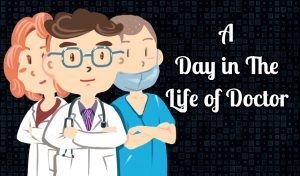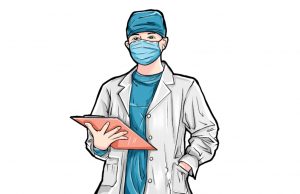A Day In the Life of a Doctor: The medical field is a prestigious one. If a doctor is doing his job well, he will look after the sick people. He works tirelessly to alleviate human suffering daily. He looks after the sick. He either provides them the medicine they require or prescribes it if he does not have it on hand. No such thing as a “normal” day exists. Every day is different, and there are a variety of physicians to choose from.

The list of specialists includes gynecologists, endocrinologists, oncologists, gastroenterologists, and so on. it’s understandable that their lives will never be the same. Back-to-back meetings account for eight or more hours of labor. Seeing patients is a doctor’s normal routine, and each session is effectively a meeting with a customer.
You go through the case’s specifics, attempt to figure out what’s going on, and then figure out the medications–often in under a half-hour. The thought process is similar to diagnosing a piece of malfunctioning equipment, only this one is made by a foreign company. You have thousands of varied, yet primitive tools, and you can only attempt to repair the gadget so many times. When a patient presents with a complaint, you consider a variety of possibilities (your differential diagnosis) and then ask questions to narrow it down and distinguish it from other issues.
Then you select your tests in the hopes of narrowing down the source of the problem to a specific cause (your diagnosis). Then you determine whether or not the issue can be resolved. The work environment determines the deeper aspects of the profession. Being a member of a hospital’s medical team is analogous to being a military officer or a middle manager in a large firm. Middle managers aren’t paid to do the dirty work; they’re paid to figure out what needs to be done, see that it gets done, and bear the repercussions of both good and bad decisions.
Meeting with patients to learn about their issues, recording your findings and thought processes, creating orders, and relaying those orders to other healthcare professionals so that they may be followed out are all part of the job. Clinic work is more analogous to running a small business. The goal is the same, but you have a little more autonomy and control over the setup, however, you won’t be able to get your findings or make changes as soon.
Recommended: Best countries to practice as a doctor
Early In the Morning Before Going to Work
Doctors typically work long days due to their wide range of duties, thus they don’t have the luxury of starting their day late. They normally get up at 6:00 am. to start their day. They are always health-conscious and make sure to have a nutritious breakfast to keep them going throughout the day.

Also see: Best and cheap countries to study and work
From The Period of Arrival to Lunch
At 8:30 am, doctors often arrive at the hospital. They look at their calendar to check whether they have any appointments scheduled for the day and prepare themselves based on the patient profiles who have scheduled appointments. Walk-in patients are frequently seen by government hospital doctors during non-appointment hours. Patients’ typical sessions entail attempting to comprehend and resolve their health-related issues.
Patients are not always willing to share their medical difficulties, therefore doctors must learn to make their patients comfortable and create a welcoming environment in which they can relax and openly discuss their issues. In a government-run hospital, because a general practitioner isn’t often trained in a single field, he may treat a wide range of conditions, from a diabetic patient with high blood pressure to a newborn boy with a sticky eye and a pregnant woman who needs a routine check-up.
In the hospital, the daily routine begins early. Blood tests are frequently conducted extremely early in the morning because doctors rely on the results of a patient’s blood tests to choose what to do during the day. A patient’s vital signs (blood pressure, temperature, oxygen saturation, heart rate, and weight) are collected early in the morning by the nurse or nursing assistant in addition to blood tests. In the morning, the physicians check on the patients to see how they are doing.
These are referred to as “rounds” by doctors. Many doctors do rounds with the whole healthcare team – residents, nurses, pharmacists, and so on. Rounds can happen extremely early in the morning, depending on what else the doctor needs to accomplish that day.

Recommended: Advantages and Disadvantages of Studying Abroad
From Late Morning to Early Afternoon
Spends the following hour taking or making phone calls to patients who are unable to attend planned appointments, or who may not be required to do so if the consultation is only a follow-up. Can also finish any paperwork leftover from the morning session. The practice’s personnel get together to talk about various topics. These judgments might be business-related or more difficult to make when it comes to patients.
A GP rarely works alone; instead, he or she is part of a team of GPs who all do their jobs at the same time. This method cuts down on hospital wait times and ensures that patients receive timely and complete care. Another advantage of working in a group is that the job is divided and no one doctor bears the whole of the responsibility. New members of the team may stop over to say hello. Your physicians have requested these new members of the team to provide them with guidance on certain issues.
Consultants are the title given to these doctors. Even though you have previously informed the physicians who have cared for you about your medical history, the consultants may ask you to repeat it or ask you questions that your other doctors have not. It might be tedious to continually recount your narrative, but it is necessary since consultant doctors frequently have different concerns than the doctors who brought you to the hospital.
When the physicians re-examine your medical history, they may uncover answers to questions that the consultant needs to offer suggestions regarding additional tests or treatments that you require. For example, if you have had surgery in the hospital and your kidneys cease working soon afterward, the surgeons may refer you to a specialist who specializes in kidneys.
Also see: How to know an intelligent person: 12 Signs
From Mid-Afternoon to Closing/Late Evening
Visits clients in their homes as needed and completes additional documentation. Blood tests must always be checked, patient documents must be completed, and so on. Continues to work until all patients have been seen. A GP may still become involved (owing to responsibility for the entire practice) if there are delays or difficulties with other staff’s patients, and often does not get to see the final patient until 6.30 pm.
The physicians will begin to go home around supper time. There are fewer physicians at the hospital caring for patients at night. The physicians who depart will inform the remaining doctors about you. If you become unwell throughout the night or require medical attention while your doctor is not available, the nurses can contact the doctor who is available at night. This doctor can prescribe more tests and medications, as well as call your home doctor if required.
Recommended: Lawyer and Doctor, Who is More Important in the Society
Conclusion
If you want to be a doctor, we can tell you that it will be a thrilling adventure. Although obtaining a medical degree is thought to be difficult, it is not that difficult. Most medical schools have adopted contemporary, more practical teaching methods to ensure that medical students enjoy a stress-free university experience.

Edeh Samuel Chukwuemeka, ACMC, is a lawyer and a certified mediator/conciliator in Nigeria. He is also a developer with knowledge in various programming languages. Samuel is determined to leverage his skills in technology, SEO, and legal practice to revolutionize the legal profession worldwide by creating web and mobile applications that simplify legal research. Sam is also passionate about educating and providing valuable information to people.